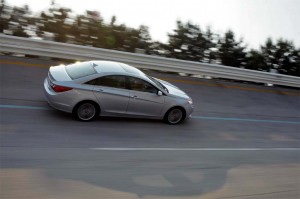
Fuel cell vehicles, battery cars and advanced gasoline technology, like that used in the new Sonata Turbo will be needed, said CEO Krafcik.
Korean carmaker Hyundai has laid out a “stretch target” of hitting an average 50 mpg fuel economy by 2025, a senior official announced to an industry conference.
John Krafcik says one of the core philosophies at Hyundai is a desire to stretch to reach what may seem to be unattainable goals – including mileage numbers many industry leaders see as impossible or close to it.
“We never set a target that we know how to hit,” the president and CEO of Hyundai Motor America told a session at the Management Briefing Seminars in Traverse City.
With that, Krafcik said that the company has pledged to reach an average corporate average fuel economy of 50 mpg in the next 15 years.
“Is that a stretch target, yeah,” Krafcik said. “We want to lead the industry in fuel economy. We want to set the trajectory.”
Hyundai already lays claim to being the most fuel efficient automaker in 2009, Krafcik said, with a corporate average of 30.9 mpg – though critics point out that the maker doesn’t have full-size trucks in its line-up to drive down its fleet average.
U.S. Corporate Average Fuel Economy regulations call for automakers to average 35.5 mpg by 2016, but that will be just a start for the industry, most experts anticipate.
Achieving that goal will require a mix of technologies including fuel cells, battery electric vehicles and hybrids, but Krafcik predicted 75 to 80% of Hyundai’s 2025 fleet will be powered by traditional internal combustion engines.
Hyundai’s current efforts to boost fuel economy include:
• A new 2.4-liter gasoline direct injection engine which debuted in the 2011 Sonata.
• Sonata Blue Drive, a hybrid, which will use a new lithium polymer battery, due out later this year.
• A new 274-horsepower 2.0-liter turbo gdi engine will debut as the optional powerplant in the Sonata instead of a heavier, less-efficient V-6.
(Click Here for the review of the 2011 Hyundai Sonata Turbo.)
But Krafcik also offered a teaser, saying that the company would show a car at this autumn’s Los Angeles Auto Show that will be “part of the puzzle” for future fuel economy increases.
(Click Here for more on Hyundai’s advanced technology strategy.)

This 2025 target of Hyundai is possible today with the MultiAir/UuniAir technology of FIAT/Schaffler-INA.
The digital control that FIAT invented (and realizes in collaboration to Schaeffler-INA) has far better / stricter control over the engine-breathing than any other known system (like BMW’s valvetronic, Toyota’s valvematic, Nissan’s VVEL, Hyundai’s VVA etc).
The right digital control over the valves is the key for better fuel-economy and cleaner-exhaust.
Yet FIAT’s and Schaeffler-INA’s MultiAir uses the digital control the wrong way (Ingoing Air Control).
By the Outgoing-Air-Control, at http://www.pattakon.com/pattakonHydro.htm , the 2025 target of Hyundai is within their hands today.
Manousos Pattakos